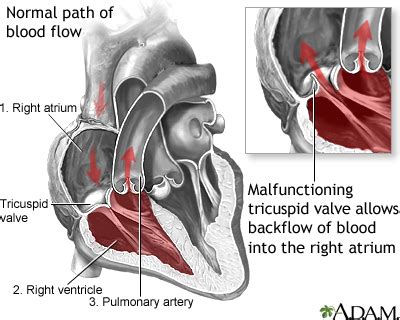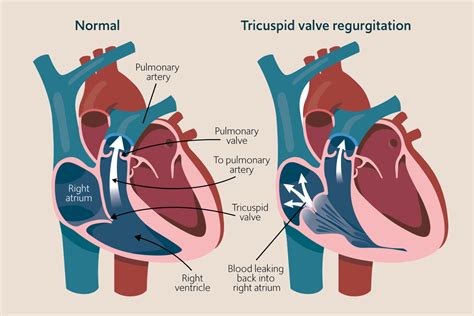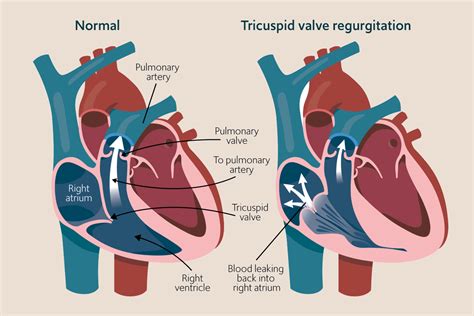Intro
The tricuspid valve is one of the four heart valves that play a crucial role in maintaining the heart's pumping function. Located between the right atrium and the right ventricle, the tricuspid valve allows blood to flow from the right atrium into the right ventricle, while preventing it from flowing backward. However, when this valve becomes damaged or diseased, it can lead to a condition known as tricuspid valve regurgitation. In this condition, the tricuspid valve does not close properly, allowing blood to leak backward into the right atrium. This can lead to a range of symptoms and complications, making it essential to understand the causes, symptoms, diagnosis, and treatment options for tricuspid valve regurgitation.
Tricuspid valve regurgitation is a relatively common condition, affecting up to 1.4% of the general population. It can occur in people of all ages, although it is more common in older adults. In some cases, tricuspid valve regurgitation can be asymptomatic, while in others, it can lead to significant symptoms and complications. The condition can be caused by a range of factors, including rheumatic heart disease, endocarditis, congenital heart defects, and pulmonary hypertension. Understanding the causes and risk factors for tricuspid valve regurgitation is essential for developing effective treatment and management strategies.
The symptoms of tricuspid valve regurgitation can vary depending on the severity of the condition. In some cases, people may experience no symptoms at all, while in others, they may experience fatigue, shortness of breath, swelling in the legs and feet, and chest pain. In severe cases, tricuspid valve regurgitation can lead to heart failure, arrhythmias, and even sudden death. It is essential to seek medical attention if you are experiencing any of these symptoms, as early diagnosis and treatment can significantly improve outcomes.
Causes and Risk Factors

Types of Tricuspid Valve Regurgitation
Tricuspid valve regurgitation can be classified into several types, depending on the severity and cause of the condition. Mild tricuspid valve regurgitation is characterized by a small amount of blood leaking backward into the right atrium. Moderate tricuspid valve regurgitation is characterized by a moderate amount of blood leaking backward, while severe tricuspid valve regurgitation is characterized by a large amount of blood leaking backward. The type and severity of tricuspid valve regurgitation can help guide treatment decisions and determine the need for surgical intervention.Diagnosis and Testing

Treatment Options
Treatment for tricuspid valve regurgitation depends on the severity of the condition and the presence of symptoms. Mild tricuspid valve regurgitation may not require treatment, while moderate to severe tricuspid valve regurgitation may require surgical intervention. Surgical options include tricuspid valve repair or replacement, which can be performed using open-heart surgery or minimally invasive techniques. Medications such as diuretics and beta blockers may be used to manage symptoms and slow disease progression. In some cases, transcatheter tricuspid valve repair may be an option, which involves using a catheter to repair the tricuspid valve.Complications and Prognosis

Lifestyle Modifications
Lifestyle modifications can play an essential role in managing tricuspid valve regurgitation and reducing the risk of complications. Quitting smoking, exercising regularly, and maintaining a healthy weight can help reduce the strain on the heart. A healthy diet that is low in salt and rich in fruits, vegetables, and whole grains can also help manage symptoms and slow disease progression. Avoiding strenuous activities and getting enough rest can also help manage symptoms and reduce the risk of complications.Current Research and Future Directions

Conclusion and Recommendations
In conclusion, tricuspid valve regurgitation is a complex condition that requires a comprehensive treatment approach. Understanding the causes, symptoms, diagnosis, and treatment options for tricuspid valve regurgitation is essential for developing effective management strategies. Lifestyle modifications, such as quitting smoking, exercising regularly, and maintaining a healthy weight, can play an essential role in managing symptoms and reducing the risk of complications. Current research is focused on developing new treatments and improving outcomes for people with tricuspid valve regurgitation. By working together, healthcare providers and patients can develop personalized treatment plans that address the unique needs and circumstances of each individual.What are the symptoms of tricuspid valve regurgitation?
+The symptoms of tricuspid valve regurgitation can vary depending on the severity of the condition and may include fatigue, shortness of breath, swelling in the legs and feet, and chest pain.
How is tricuspid valve regurgitation diagnosed?
+Tricuspid valve regurgitation is typically diagnosed using a combination of physical examination, medical history, and diagnostic testing, including electrocardiogram (ECG), chest X-ray, echocardiogram, and cardiac catheterization.
What are the treatment options for tricuspid valve regurgitation?
+Treatment for tricuspid valve regurgitation depends on the severity of the condition and the presence of symptoms. Mild tricuspid valve regurgitation may not require treatment, while moderate to severe tricuspid valve regurgitation may require surgical intervention, including tricuspid valve repair or replacement.
We hope this article has provided you with a comprehensive understanding of tricuspid valve regurgitation, including its causes, symptoms, diagnosis, treatment options, and complications. If you have any further questions or concerns, please do not hesitate to comment below or share this article with others who may be interested. Additionally, we invite you to explore our other articles and resources on heart health and cardiovascular disease. By working together, we can promote greater awareness and understanding of these important topics and improve outcomes for individuals affected by heart disease.
